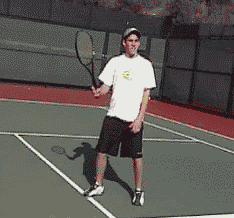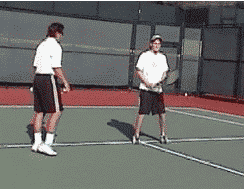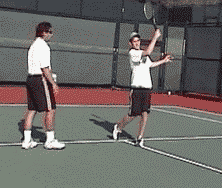<% ns_puts [mkm_getnavbar] %>
Balance and Vision II
by Jim McLennan
Click photo to view video. |
There have been many questions about follow-up materials from the previous article I wrote on balance and vision. I will try to describe on court methods I use to convey the “feel” of balance and focused vision. For myself (as a teacher) it is important that students get past the descriptions and language and learn how these things feel.
Toss, Hit, Catch
The first exercise on court is toss hit catch. I am positioned a few feet from the net; the student is a few feet from the net on the other side of the court. I will toss, he will hit, and I will catch.
I ask him to prepare the racquet on the forehand side so I can aim my toss in the general direction of his racquet face. I toss a few easy ones to see if he can gently “bump” it back to me in the air. Now, I begin another toss but do not release the ball, to get his to feel what his first reaction is. If he is leaning off balance at this moment I make note, if his head is tilted to either side I make another note, if his knees or elbows are locked yet another observation, and if he flinched in any way on this fake toss we note that as well.
|
|
The idea is to call attention to a simple preparation that does not alter posture, does not lock elbows or knees; does not tilt the head, and is not trusted for if he flinched he is “saying” he is not comfortable. With practice he will learn to execute a simple bump volley without losing balance, or without interrupting his vision.
Progressions include preparing the racquet, weighting the leg on the forehand side, and unweighting the other leg so the knee is bent loosely, and he can tap that toe repeatedly without losing balance. Now the tosses are either to his, no footwork required, or away so that the “off” leg can easily crossover. Again reference is made to posture, ease of movement, and the task of volleying with the least extraneous movement. See our library with the author sitting on a stool volleying to get a visual picture of the minimum required to accomplish a task.
Drop Hit Groundstrokes
In this exercise we move to the baseline together. I ask him to turn sideways to the net, with any type of preparatory backswing, it can be short or long, high or low - his choice. I drop a few and let him stroke them over the net. Then on the next drop before he begins to swing I ask him to freeze and once again note his posture, whether his head is tilted lowered or held high, and precisely at this moment the balance on his back foot to see if the front leg is unweighted (correct) or not.
|
|
Adjustments
are made to this initial pose; then again we stroke the ball a few times.
Now I ask him to freeze on a follow-through, holding the finish. Again
note of the alignment of the eyes, a imaginary line between them should be
horizontal, note of the posture, is the weight now balanced over the front
foot, and if so can he now tap the toe of the back foot repeatedly
without losing balance. If all goes well he now feels when it is right
and when it isn’t.
Now in gentle rallying, I can call attention to head alignment, posture,
balance at the start or finish, and he will not always get it right but
equally can generally feel when it is easy and when it is not (dis-ease).
You and a friend can do these drills together, and easily get a more
specific feel for your balance. In the process you will find you are
playing with less effort, with more rhythm, and with an ease of movement.
Tom Stow would tease me (and I hope others) about their off-balanceness,
noticing the scuffs on all parts of my shoes and asking with a smirk how I
would have to contort my leg and body to have scuffed this or that part of
the shoe. As I was wondering, he would then remind me that Don Budge’s
shoes always looked new. And that once in a photo shoot for Pic magazine,
where Fred Astaire’s dancing poses were compared to those of Don Budge.
Don told Fred how graceful he was and what a pleasure it was to work with
his idol. Whereupon Fred corrected Don and said that no, Don was the
graceful one and in fact was Fred’s idol. Such I suppose it is with the
gifted.
|
|
As an aside, my interest in balance came from initial lessons with Tom Stow. Related references I found over the years that supplemented, and even redirected, his work include the following: The Art of Seeing by Aldous Huxley. Body and Mature Behavior by Moishe Feldenkrais. Resurrection of the Body by FM Alexander, Batting Basics by John White. Huxley puts a different spin on vision, visual exercises and “pre-vision”. Feldenkrais did extensive work in physical therapy with an eye to structural integration and the alignment of the body. Alexander worked with theater performers on posture, projection and carriage of the body. And as I have noted elsewhere within TennisONE, White worked on rotational batting mechanics with reference to gyroscopic stability.
Most of the ideas overlap, balance improves vision, gyroscopic stability is related to balance and influences vision, posture is the link to all of these systems, and somehow the greatest of our players past and present all had this same look, poised, effortless, erect, and somehow quiet amidst the chaos of a point. Though some have written that tennis is a game of emergencies, balance and vision are the counter point, that is the player is trying to move smoothly, quickly, but always on balance, never hurried yet always on time.
| Want to read more of Jim McLennan's unique insight into learning tennis? Check out his other original articles in the TennisONE Lesson Library. | |
Your comments are welcome. Let us know what you think about Jim McLennan's article by emailing us here at TennisONE.
|
Click here to order. |
The Secrets of World Class Footwork - Featuring Stefan Edberg
Pattern movements to the volleys, groundstrokes, and split step reactions. Rehearse explosive starts, gliding movements, and build your aerobic endurance. If you are serious about improving your tennis, footwork is the key.
29.95 |
To contact us, please email to: webmaster@tennisone.com
TennisONE is a registered trademark of TennisONE and SportsWeb ONE; Copyright 1995. All rights reserved.





